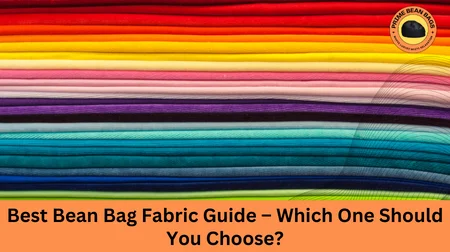The era of traditional seating is gradually giving way to a more relaxed and versatile alternative – the beloved bean bag. As bean bags continue to gain popularity in modern living spaces, the significance of choosing the right fabric cannot be overstated.
This comprehensive guide aims to unravel the complexities of bean bag fabrics, providing insights into various options to help you make an informed decision tailored to your preferences and lifestyle.
Table of Contents
Comfort Matters: Fabric’s Role in Bean Bag Comfort
At the heart of the bean bag experience lies the pursuit of unparalleled comfort. The fabric you select plays a pivotal role in dictating the overall comfort of your bean bag. Softness, breathability, and the immediate feel against your skin – these elements are all influenced by the fabric choice.
But comfort is subjective, and personal preferences come into play. Whether you lean towards the plush coziness of cotton or prioritize the durability of polyester, finding the perfect balance ensures your bean bag becomes a haven of relaxation in your home.
Cotton Comfort: Pros and Cons
Cotton stands as a favored fabric for bean bags due to its natural softness and breathability. The tactile pleasure of sinking into a cotton-covered bean bag is unmatched. However, this comfort comes with its considerations.
Maintenance becomes a crucial factor as cotton may demand more care to stay in top condition. Furthermore, its durability may not rival that of some synthetic alternatives. Thus, the allure of cotton lies in striking a balance between luxury and the willingness to invest a bit more time in its upkeep.
Polyester Picks: Durable Comfort
For those prioritizing durability without sacrificing comfort, polyester emerges as a reliable choice. Polyester fabrics boast resistance to wear and tear, ensuring your bean bag retains its comfort over an extended period.
Yet, this durability comes at a potential cost – some may find polyester lacking in the breathability department. In this fabric choice, it becomes a delicate dance between longevity and the immediate comfort sought from a bean bag.
Faux Leather – Chic and Practical
Faux leather introduces an element of sophistication to your living space while retaining practical benefits. Its sleek and modern appearance elevates the aesthetic appeal of your bean bag. Moreover, the ease of cleaning makes it a practical choice for households where spills are inevitable.
However, potential downsides include reduced breathability compared to natural fabrics. Choosing faux leather is about finding a harmonious blend between style and practicality, ensuring your bean bag remains both chic and easy to maintain.
Microfiber Magic: Cozy and Stain-Resistant
Microfiber stands out for its luxurious feel and stain-resistant properties. It strikes a perfect balance between comfort and practicality, making it an ideal choice for those desiring a cozy yet low-maintenance bean bag.
The plush touch of microfiber transforms your bean bag into a sanctuary of comfort, while its resilience against stains ensures a worry-free experience. Choosing microfiber involves embracing the magic of both comfort and practicality in one delightful package.
Outdoor Adventures: Fabric for Outdoor Bean Bags
Taking your comfort outdoors requires careful consideration of the fabric. Opt for options explicitly designed to withstand the elements, including waterproof and weather-resistant fabrics.
Balancing durability with comfort becomes paramount for outdoor bean bags, ensuring they stand resilient against nature’s forces while providing the comfort expected from a traditional indoor bean bag.
Fabric Trends: What’s Hot Right Now?
The world of bean bag fabrics is not exempt from trends. From bold patterns to subtle textures, various fabric options cater to diverse tastes. Exploring the latest trends involves not only considering aesthetics but also aligning fabric choices with your lifestyle and design preferences.
Your bean bag can become a statement piece, reflecting your individual style in the ever-evolving world of fabric trends.
DIY Covers: Fabric Choices for Crafty Enthusiasts
For the creative souls who find joy in crafting, making your own bean bag cover can be a fulfilling project. The fabric options available for DIY covers span from vibrant prints to neutral tones, offering a canvas for your creativity.
Whether you’re an experienced DIY enthusiast or a novice eager for a fun project, selecting the right fabric sets the foundation for crafting a unique bean bag cover that mirrors your style and creativity.
Sustainability Matters: Eco-Friendly Fabrics
In an era increasingly defined by environmental awareness, the demand for eco-friendly fabric options has surged. Discover sustainable choices for bean bag fabrics, including organic cotton, hemp, and recycled materials.
Balancing sustainability with other factors becomes crucial, allowing you to make an environmentally conscious decision without compromising on comfort or durability.
Kids and Pets: Kid-Friendly and Pet-Friendly Fabrics
Homes with children and pets require bean bag fabrics that can withstand inevitable spills and stains. Opt for fabrics resistant to mishaps and easy to clean, ensuring your bean bag remains a stress-free zone for both kids and pets.
Safety considerations also play a vital role, prompting the choice of non-toxic fabrics that prioritize the well-being of your loved ones.
Fabric Maintenance 101
Irrespective of the fabric chosen, proper maintenance is paramount for the longevity of your bean bag. General tips for maintaining bean bag fabric include establishing regular cleaning routines and adhering to care guidelines specific to the chosen fabric.
Nurturing your bean bag with consistent care guarantees that it continues to look and feel its best over time.
Budget-Friendly Options: Quality on a Budget
Quality need not be synonymous with a hefty price tag. Delve into budget-friendly fabric options that offer a balance between durability and comfort. Identifying cost-effective choices aligning with your preferences and lifestyle proves that a comfortable and stylish bean bag is within reach without straining your budget.
Choosing the Right Size: Fabric’s Impact on Size Selection
Beyond comfort and fabric type, the fabric you choose can influence the overall size and shape of your bean bag. Contemplate how different fabrics may alter the dimensions and ensure your chosen size seamlessly integrates into your living space.
The right size is not merely about the space it occupies but also about how well it complements the room’s aesthetics.
Conclusion
In the expansive realm of bean bag fabrics, the key lies in striking a delicate balance between comfort, durability, and personal style. Each fabric type brings its unique characteristics to the table, and the best choice hinges on your individual preferences and lifestyle.
Whether your priority is comfort, durability, or staying ahead of the latest trends, there exists a bean bag fabric perfectly suited to your needs. Elevate your relaxation experience by choosing a fabric that transforms your bean bag into a personalized sanctuary.
FAQs – Frequently Asked Questions
Can I use outdoor bean bags indoors?
Yes, outdoor bean bags can be used indoors. However, consider the fabric’s texture and comfort level for optimal indoor use.
How often should I clean my bean bag?
Cleaning frequency depends on the fabric type and usage. A regular cleaning routine is generally recommended to maintain hygiene.
Are DIY bean bag covers easy to make?
Making DIY bean bag covers can be relatively easy with basic sewing skills. Numerous online tutorials and patterns are available for guidance.
Can I use bean bags with faux leather in a sunny room?
While faux leather is durable, prolonged exposure to direct sunlight may affect its longevity. Consider placing it in shaded areas or using curtains to protect it.
Are there any eco-friendly options for bean bag fabrics?
Yes, several eco-friendly options exist, including organic cotton, hemp, and recycled materials. Check product descriptions for sustainability credentials.

